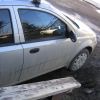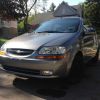This has happened at least two times before and anywhere that experiences winters and road salting one can expect a seized (Edit: not yet, seizing) brake caliper to happen from time to time (my sisters 4 yr old honda already happened on the rear calipers, these calipers, rotors and pads are 3 1/2 yrs old circa april '14). It is my understanding that if you get it at the start you will save your rotor and having to buy a new caliper. So I'm documenting this because it might help someone else who also has more time on their hands than cash to burn at a shop.
For those who don't know me I'm a beginner mechanic with a fabricators mind - think good looking geek but no idea that more than half of car repair has to do with rusty nuts/bolts, broken studs, hacksaws, penetration lubricants of all kinds, blowtorches (yes two, are better than one apparently), and the cutting torch. I love this car because its proven to be cheap to maintain and modify.
So its a passenger front dragging caliper we got here, doing it myself this time because there is access to a residential garage with halogen lights that warm things up enough to be tolerable. By jacking up the front, removing the rims, fully applying the brakes and then spinning the wheels its totally apparent - the passenger front tire not only is waay stiff to rotate but it makes a light scraping sound as it turns. Also the pad has 1/8" less chuch on it than the drivers side. Uh ooh, should have done this sooner, I say to myself.
First off, what this forum already has on the topic based upon my choice of relevant search keywords:
Brake Trouble
Replacing front brake rotors
Wheel Shake
Next up:
-to see if I can get this caliper to smoothly operate again, using the caliper tool and wood
-if so will do the same to drivers side caliper since its probably close to same
-lastly, to discuss bleeding not just the fronts, but the rears, and whether the brake fluid should be swapped out
Thats all for today, back to work.



 LinkBack URL
LinkBack URL About LinkBacks
About LinkBacks

 Sparky
Sparky Sparky II
Sparky II
 Reply With Quote
Reply With Quote 2005 Chevrolet Aveo LT
2005 Chevrolet Aveo LT
 . Bet I'm not the first one to do that hehe.. so a lot was learned in this task. For now alls I did was free up the piston on the passenger side, I'm going to order a new seal and install that next. I think this should do the trick for the winter.. so test drive today went fine, I think there is a tiny tiny bit of shake on the passenger side but its really minimal, I'm going to keep driving and see what happens, might replace that rotor (Edit: no rotor is fine because braking is smooth, the wheel is prob out of balance). Now that I know how to do the front and rear brakes I've got a lot more confidence to tackle something a bit more difficult, that control arm. And installing the new end link adapters rabbit sent me.
. Bet I'm not the first one to do that hehe.. so a lot was learned in this task. For now alls I did was free up the piston on the passenger side, I'm going to order a new seal and install that next. I think this should do the trick for the winter.. so test drive today went fine, I think there is a tiny tiny bit of shake on the passenger side but its really minimal, I'm going to keep driving and see what happens, might replace that rotor (Edit: no rotor is fine because braking is smooth, the wheel is prob out of balance). Now that I know how to do the front and rear brakes I've got a lot more confidence to tackle something a bit more difficult, that control arm. And installing the new end link adapters rabbit sent me.